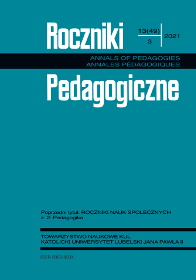Perspectives of Continuous Monitoring of Alcohol Concentration in Case of Prisoners
Main Article Content
Abstract
The consumption of alcohol is a serious violation of prison security. This incident strongly disturbs the process of change-forming effect applied to this person. Due to such events random sobriety checks are practiced in prisons, especially to prisoners returning from activities outside penitentiary as well as to those returning from passes.
Controlling the sobriety of prisoners with the use of previously available breath alcohol measuring devices makes the system porous. The reason is that in case of jailed people the requirement to measure means contact between the monitored inmate and the device is done almost exclusively on the premises of the prison. It would be beneficial to complement this system by using devices that monitor the alcohol concentration level on a continuous basis (also when the prisoner is outside the penitentiary), preferably without the direct involvement of third parties (e.g. security guards) in the measurement itself.
The article is based on an expert opinion prepared in 2020 for the Minister of Justice in Poland. The article discusses the prospects of using the continuous alcohol monitoring system with regard to inmates. This issue was raised in relation to people using passes, employed outside the prison premises and those conditionally released from penitentiaries.
Article Details
References
Dingwall, G. (2013). Alcohol use and Crime. W: G. Dingwall (red.), Alcohol and Crime. Routledge.
Fidelus, A. (2020). Uwarunkowania readaptacji społecznej skazanych − podstawy teoretyczne i aspekty praktyczne. The Prison Systems Review, 107,2.
Frąckowiak, M., Motyka, M. (2015). Charakterystyka problemów społecznych związanych z nadużywaniem alkoholu. Hygeia Public Health, 50(2), 314-322.
Głowik, T. (2019). Change in paradigms in addiction therapy. Resocjalizacja Polska, 17. DOI: 10.22432/pjsr.2019.17.08.
Graham, L., Parkes, T., McAuley, A., Doi, L. (2012). Alcohol problems in the criminal justice system: an opportunity for intervention. Copenhagen: WHO.
Greenfield, T.K., Bond, J., Kerr, W.C. (2014). Biomonitoring for Improving Alcohol Consumption Surveys The New Gold Standard?. Alcohol Rec., 36(1), 39-45.
Goniewicz, G. (2017) Pozytywna prognoza kryminologiczna jako przesłanka stosowania środków probacyjnych. Czasopismo Prawa Karnego i Nauk Penalnych, 21,4.
Iwanowska, A. (2013). Przygotowanie skazanych do życia na wolności w trybie art. 164 k.k.w. Warszawa: RPO.
Kotowska, K. (2020). Realizacja prawa osób pozbawionych wolności do poszanowania życia rodzinnego w kontekście stosowania art. 141a § 1 Kodeksu karnego wykonawczego. The Prison Systems Review, 108.
McKnight, A.S., Fell, J.C., Auld-Owens, A. (2012). Transdermal alcohol monitoring: Case studies. (Report No. DOT HS 811 603). Washington, DC: National Highway Traffic Safety Administration.
Miesięczna informacja statystyczna, październik 2020 r. Ministerstwo Sprawiedliwości, Centralny Zarząd Służby Więziennej, Warszawa. dostępny na: https://sw.gov.pl/strona/statystyka--miesieczna (otwarty 23.11.2020).
Nowak, B., Kasprzyk, M., Mielnik, D., Skowron, D., Trzeszczkowska, M., Łapiński, P., Grzesiak, S., Nowacki, Z., Zawadzka, M., Pytka, A., Stachowicz, A. (2020). Możliwości adaptacji systemu transdermalnego monitorowania stężenia alkoholu (TMSA) do polskich uwarunkowań prawno-społecznych. Ekspertyza Instytutu Badawczo-Rozwojowego Wyższej Szkoły Kryminologii i Penitencjarystyki w Warszawie. Dostępne w Internecie: https://wskip.edu.pl/aktualności.
Roberts, W., McKee, S.A. (2018). Mobile Alcohol Biosensors and Pharmacotherapy Development Research. Alcohol. DOI: 10.1016/j.alcohol.2018.07.012.
Roczna informacja statystyczna za rok 2019. Ministerstwo Sprawiedliwości, Centralny Zarząd Służby Więziennej, Warszawa. dostępny na: https://sw.gov.pl/strona/statystyka-roczna (otwarty 04.12.2020).
Shammas, V.L. (2017a). Pains of imprisonment. W: K.R. Kerley (red.), The Encyclopedia of Corrections. Wiley-Blackwell.
Shammas, V.L. (2017b). The Society of Captives. W: K.R. Kerley (red.), The Encyclopedia of Corrections. Wiley-Blackwell.
Szczygieł, G.B. (2013). Zezwolenia na czasowe opuszczenie zakładu karnego w polskim systemie penitencjarnym. Białystok: Temida 2.
Talpins, S., Robertson, R., Holmes, E., Dunagan, M. (2013). Alcohol and crime. W: P. Boyle, P. Boffetta, A.B. Lowenfels, H. Burns, O. Brawley, W. Zatoński, J. Rehm (red.), Alcohol: Science, Policy and Public Health. Oxford University Press. DOI: 10.1093/acprof:oso/9780 199655786.003.0023.
Wang, Y., Fridberg, D.J., Leeman, R.F., Cook, R.L., Porges, E.C. (2018). Wrist-Worn Alcohol Biosensors: Strengths, Limitations, and Future Directions. Alcohol. DOI: 10.1016/j.alcohol. 2018.08.013.
Włodarczyk, E. (2018). Społeczne konsekwencje problemu alkoholowego w Polsce. Pedagogika Społeczna, 2(68).
Wojcieszek, K. (2019). Propozycja dla Polski: trzeźwość. Studium z zakresu pedagogiki społecznej. Warszawa: DiG.

